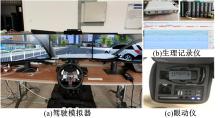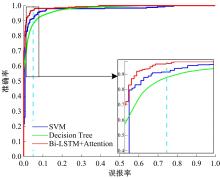Journal of Jilin University(Engineering and Technology Edition) ›› 2022, Vol. 52 ›› Issue (8): 1800-1807.doi: 10.13229/j.cnki.jdxbgxb20210215
A recognition method for driver's cognitive distraction in simulated mixed traffic environment
Qiang HUA1( ),Li-sheng JIN1,2(
),Li-sheng JIN1,2( ),Bai-cang GUO1,Shun-ran ZHANG1,Yu-han WANG1
),Bai-cang GUO1,Shun-ran ZHANG1,Yu-han WANG1
- 1.College of Transportation,Jilin University,Changchun 130022,China
2.School of Vehicle and Energy,Yanshan University,Qinhuangdao 066004,China
CLC Number:
- U461.91
| 1 | Nee M, Contrand B, Orriols L, et al. Road safety and distraction, results from a responsibility case-control study among a sample of road users interviewed at the emergency room[J]. Accident Analysis and Prevention, 2019, 122: 19-24. |
| 2 | Metz B, Landau A, Just M. Frequency of secondary tasks in driving-results from naturalistic driving data[J]. Safety Science, 2014, 68: 195-203. |
| 3 | Klauer S G, Guo F, Simons-Morton B G, et al. Distracted driving and risk of road crashes among novice and experienced drivers[J]. The New England Journal of Medicine, 2014, 370(1): 54-59. |
| 4 | Haque M M, Washington S. A parametric duration model of the reaction times of drivers distracted by mobile phone conversations[J]. Accident Analysis and Prevention, 2014, 62: 42-53. |
| 5 | Ross V, Jongen E M, Wang W, et al. Investigating the influence of working memory capacity when driving behavior is combined with cognitive load: an LCT study of young novice drivers[J]. Accident Analysis and Prevention, 2014, 62: 377-387. |
| 6 | Strayer D L, Watson J M, Drews F A. Cognitive distraction while multitasking in the automobile[J], Psychology of Learning and Motivation, 2011, 54: 29-58. |
| 7 | Young K L, Salmon P M. Examining the relationship between driver distraction and driving errors: a discussion of theory, studies and methods[J]. Safety Science, 2012, 50(2): 165-174. |
| 8 | Sharma A, Ali Y, Saifuzzaman M. Human factors in modelling mixed traffic of traditional, connected, and automated vehicles[C]∥International Conference on Applied Human Factors and Ergonomics Springer, Brisbane, Australia, 2017: 262-273. |
| 9 | Strayer D L, Drews F A. Cell phone induced driver distraction[J]. Current Directions in Psychological Science, 2007, 16(3): 128-131. |
| 10 | 孙健,张一豪,王俊骅. 基于自然驾驶数据的分心驾驶行为识别方法[J]. 中国公路学报, 2020, 33(9): 225-235. |
| Sun Jian, Zhang Yi-hao, Wang Jun-hua. Detecting driver distraction behavior with naturalistic driving data[J]. China Journal of Highway and Transport, 2020, 33(9): 225-235. | |
| 11 | 张辉,钱大琳,邵春福,等.模拟驾驶环境下驾驶人分心状态判别[J]. 中国公路学报, 2018, 31(4): 47-55. |
| Zhang Hui, Qian Da-lin, Shao Chun-fu, et al. Driver's distraction states identification in simulation driving environment[J]. China Journal of Highway and Transport, 2018, 31(4): 47-55. | |
| 12 | Liao Y, Li S E, Wang W, et al. Detection of driver cognitive distraction: a comparison study of stop-controlled intersection and speed-limited highway[J]. IEEE Transactions on Intelligent Transportation Systems, 2016, 17(6): 1628-1637. |
| 13 | Liang Y, Lee J D. A hybrid bayesian network approach to detect driver cognitive distraction[J]. Transportation Research Part C, 2014, 38(1): 146-155. |
| 14 | Hua Q, Jin L S, Jiang Y Y, et al. Cognitive distraction state recognition of drivers at a nonsignalized intersection in a mixed traffic environment[J]. Advances in Civil Engineering, 2021(5): 1-16. |
| 15 | Zhou P, Shi W, Tian J. Attention-based bidirectional long short-term memory networks for relation classification[C]∥Proceedings of the 54th Annual Meeting of the Association for Computational Linguistics, Berlin, Germany, 2016: 207-213. |
| 16 | 张健,吴坤润,杨敏,等.智能网联环境下交叉口双环自适应控制模型[J]. 吉林大学学报: 工学版, 2021, 51(2): 541-548. |
| Zhang Jian, Wu Kun-run, Yang Min, et al. Double-ring adaptive control model of intersection during intelligent and connected environment[J]. Journal of Jilin University(Engineering and Technology Edition), 2021, 51(2): 541-548. | |
| 17 | Wu G, Sanderson B, Bittner V. The 6-minute walk test: how important is the learning effect?[J]. American Heart Journal, 2003, 146(1): 129-133. |
| 18 | Liao Y, Li S E, Wang W. The impact of driver cognitive distraction on vehicle performance at stop-controlled intersections[C]∥Intelligent Vehicles Symposium, Seoul, South Korea, 2015: 946-951. |
| 19 | 裴玉龙,金英群,陈贺飞.基于脑电信号分析的不同年龄驾驶人疲劳特性[J]. 中国公路学报, 2018, 31(4): 59-65. |
| Pei Yu-long, Jin Ying-qun, Chen He-fei. Fatigue characteristics in drivers of different ages based on analysis of EEG[J]. China Journal of Highway and Transport, 2018, 31(4): 59-65. | |
| 20 | 卢运梅. SVM-RFE算法在数据分析中的应用[D]. 长春: 吉林大学计算机科学与技术学院, 2009. |
| Lu Yun-mei. The application of SVM-RFE algorithm to data analysis[D]. Changchun: College of Computer Science and Technology, Jilin University, 2009. | |
| 21 | 王芳荣,郭柏苍,金立生,等.次任务驾驶安全评价指标筛选及其权值计算[J]. 吉林大学学报: 工学版, 2017, 47(6): 1710-1715. |
| Wang Fang-rong, Guo Bai-cang, Jin Li-sheng, et al. Selection of safe evaluation indexes and weight calculation for secondary task driving[J]. Journal of Jilin University(Engineering and Technology Edition), 2017, 47(6): 1710-1715. |
| [1] | MA Yong, SHI Yong-quan, FU Rui, GUO Ying-shi. Impact of driver's distracted driving time on vehicle lane departure [J]. 吉林大学学报(工学版), 2015, 45(4): 1095-1101. |
|
||









